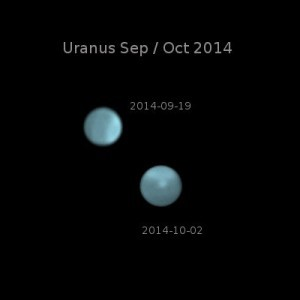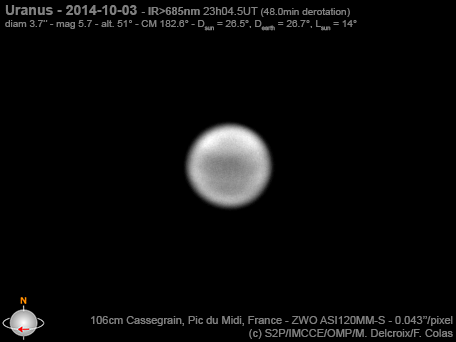If you have a large backyard telescope you can collaborate with NASA in its latest effort to investigate the ice giants, Uranus and Neptune. Most of the work will be done by the Hubble Space Telescope and the New Horizons spacecraft, but surprisingly, NASA says every little bit helps.
It’s been 37 since a mission visited Uranus and 34 for Neptune. Despite increasing pleas from the astronomical community no return is locked in, and even in the best-case scenario, it will be two decades before a spacecraft could reach Uranus. A return to Neptune could be twice as distant. Until then all we can do to learn about these two systems is comb through data from Voyager 2 for anything we missed, and view them remotely.
By combining multiple instruments, all focused on these worlds at once, astronomers think they can learn more than each could manage individually. Although the New Horizons spacecraft is even further from either planet than we are, and lacks instruments remotely as powerful as Earth’s largest telescopes, Dr Alan Stern of the Southwest Research Institute believes its perspective from the other side of the planets from the Sun – from behind, if you will – will enhance our capacity to study the pair.
“By combing the information New Horizons collects in space with data from telescopes on Earth, we can supplement and even strengthen our models to uncover the mysteries swirling in the atmospheres of Uranus and Neptune,” Stern said in a statement. “Even from amateur telescopes as small as 16 inches, these complementary observations can be extremely important.”
Telescope sizes are measured by the diameter of the primary mirror or lens, so 40 centimeters (16 inches) is far from small by backyard standards. It’s the sort of instrument only a serious amateur, or someone with plenty of money to splash around, would possess. Nevertheless, it’s puny compared to modern professional scopes.
Nonetheless, astronomy is one of the few fields of science where amateurs continue to play important roles such as discovering comets and supernovas. Just this month Australian amateur Trevor Barry was honored for his contributions, particularly in the study of Saturn, using telescopes he built himself. Barry has managed to fill in gaps about the ringed planet’s longest-lasting electrical storm the Cassini spacecraft missed, despite being thousands of times further away.

These images of Uranus demonstrate what can be done with a 40cm (16in) Newtonian telescope. The two images show the development and movement of a storm. 650-850nm filter and PGR GS3-U3-2356M camera.
Image Credit: Anthony Wesley via NASA
NASA is looking for people who can track bright features as they cross the faces of Uranus and Neptune. While Hubble can see them better, its time is too precious to spend all of it on these two objects. Instead, it will check in regularly, and rely on amateurs to keep watch at other times. The more time zones involved the better. Neptune reaches opposition mid-month so will be visible for most of the night through September. Uranus will be rising around four hours later, so will require more perseverance to catch.
Anyone suitably equipped who wants to join is invited to post their images, along with times made and filters used to Facebook and the website formerly known as Twitter with the hashtag #NHIceGiants. Meanwhile, New Horizons will follow in the footsteps of Voyager 1 by observing the sides we can’t see of the Solar System’s other pale blue dots, tracking storms as they pass from our view.

Movement of a bright spot as Uranus rotated over two hours on Oct. 4, 2014
Image Credit: Marc Delcroix and François Colas at the Pic du Midi
Those who lack a suitable telescope can experience the excitement of discovery vicariously by following the hashtag and viewing the Hubble images that will be added at the end of the month here. New Horizons takes time to transmit its images, as those who followed its passage past Pluto might recall, but the team expects to have them by the end of the year.
This project may answer questions about the ice giants’ atmospheres, including the mystery of Uranus’s low heat leakage. However, it probably won’t reveal anything new about either planets’ moons, which may be the best reason to send a mission to at least one.
Source Link: NASA Wants Your Help Studying Uranus From Behind Next Month